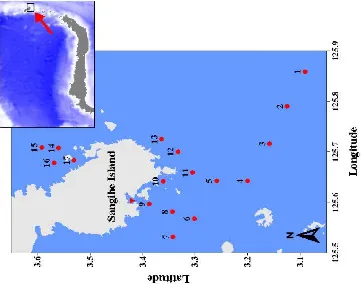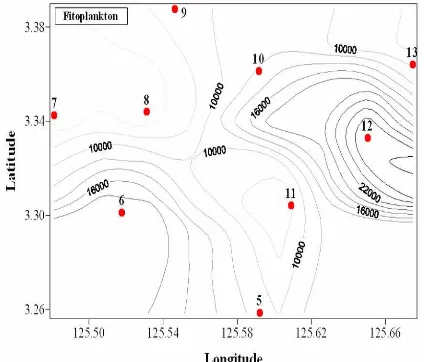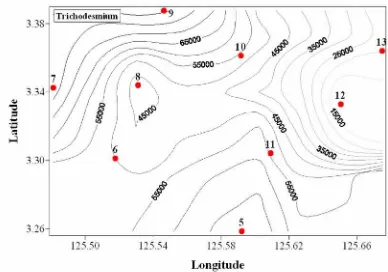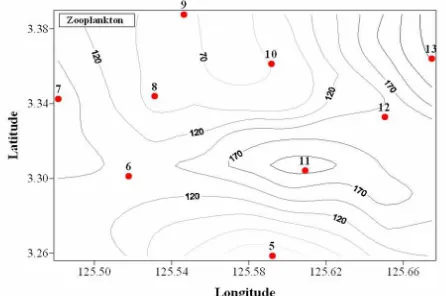The Diversity of Plankton in Sangihe – Sangir Talaud Islands,
Sulawesi, Indonesia
Hikmah Thoha and Nurul Fitriya
Plankton and Primary Productivity, Research Center for Oceanography, Indonesian Institute of Sciences,Jl. Pasir Putih No.1, , Ancol Timur, Jakarta 14430, Telp : 62 -21 – 64713850, Fax : 62
-21 – 64711948, E-mail : hikmah_thoha@yahoo.com ; nurulfitriya29@yahoo.com
Abstract
The research of Oceanographical Expedition was conducted on May 2009. Research Vessel of Baruna Jaya VIII was used to accommodate the research team, which is a part of the EWIN ( Widya Nusantara Expedition) project with a topic of discovering the ultimate frontier of Indonesia and strengthening our national resilience, such as survival, energy, and natural resources, food, disaster, and health. This paper shows plankton research with environment studies, such as temperature and salinity. Plankton was sampled using Kitahara Net with mesh size of 80 µm for phytoplankton and Norpac Plankton Net with mesh size of 300 µm for zooplankton. The sample was poured into a bottle with formalin of 4% as preservative from 13 stations. The results showed that the phytoplanktons consist of 22 diatom genera and 10 dinoflagellates. The phytoplankton
abundance was due the flourishing of Chaetoceros sp., Rhizosolenia sp., Nitzschia sp., and
Thalassiothrix sp. Ceratium sp. and Protoperidinium sp., Pyrocystis sp., and Cyanobacteria
Trichodesmium sp. were common among the dinoflagellates. The zooplanktons consist of 30 taxa,
the group of which are mostly composed of Copepoda, Calanoida, Cyclopoida, Oikopleura, and
Chaetognata. Environmental studies were also discussed.
Key words: diversity, phytoplankton, zooplankton, Sangihe – Sangir Talaud Islands
Introduction
The district of Sangihe is located in Northern Sulawesi Island of Central Indonesia bioregion. The geographical structure formed an archipelago with many islands such as Tahuna, which is the capital city of Sangihe Island Regency. There is a coral reef with a depth of 15 meters, flourishing with the coral reef fish, Anemon, hard-coral and soft-coral, which provides a magnificent view. This location is also perfect for safe night diving. The others island are Mahengetang, Kahakitang, Dagho, Bukide, Nenung, Para, and
Kendahe islands and among the district with the longest coastline in the continent. The
islands are surrounded by the most amazing features of underwater volcanic ridges
between Indonesia and Philippine through the Wallacea line and Coral Triangle, put them into and undoubtedly home for rich marine biodiversity that life coevolutes with types of magical reefs fringing these islands. The beauty and uniqueness that existed in Sangihe, encouraging local government to develop community – based conservation and ecotourism within Sangihe’s development strategy (Developing Community Base Ecoturims and Conservation, 2009).
They are like a string of pearls with their white sand beaches and fertile land upon which can be found a vast jungle, nutmeg gardens and coconut trees which decorate the foot of a mighty volcano reaching to the sky. A variety of sea life as well as beautiful wildlife and plant life inhabiting the land create an ornamental picture of nature in harmony which is complemented by the rich culture and friendliness of the local residents. The peaceful and fulfilling island atmosphere will make all visitors fell at home. The unpolluted blue sky and clear crystal waters are incomparable (Pearls of the North, 2009).
113
Biosfera 27(3) September 2010energy and natural resources, food, disaster, and health. EWIN Expedition leg-3 activities are marine dynamics such as physical oceanography, chemistry oceanography, microbiology, and plankton. This paper shows plankton research with environment studies, such as temperature and salinity.
Material and Methods
The planktons were carried out on May 2009. Planktons were collected using the Kitahara net for phytoplankton and Norpac net for Zooplankton. The plankton net is equipped with flow – meters at the mouth of the net, to calculate of filtered seawater flowing through the net. The filtered seawater is calculated using the equation : V = r.a.p (where V = volume of filtered seawater, r = rotation of flow-meter, a = area of the mouth of plankton net length of water column for one rotation). The phytoplankton net has mesh size of 80 µm and the zooplankton net has mesh size of 300 µm. The plankton net is deployed horizontally 2 – 5 minute from the sea surface and then hauled up with constant velocity. Plankton samples were removed from the bucket of the net and immediately fixed with 4% neutral formalin. Identification and enumeration of plankton is done under microscope in the laboratory. Plankton counting, sample was enumerated from a fraction ( one ml or 1/100 or more of the sample) in term of cells ( not in term of chains) for phytoplankton and 2.5 ml for zooplankton. The fraction was poured into a
Sedgwick-Rafter counting cell for phytoplankton.Zooplankton counting: Copepods were counted in a
fraction (1/4 or 1/2 of the sample) for the big sample. However, in a small sample, the whole animals were examined. The fraction (or the whole sample) was put into a round (wheel) counting chamber and the zooplankton was identified, if possible, up to the genus. In identifying copepods, all animals were generally looked through closely and enumerated. In some cases where the animal was in the larval stage or difficult to recognize, it was identified into the order or the class of the taxon ( Wickstead, 1961; Taylor, 1994; Sekiguchi, 2007).
Results and Discussion
The islands under study are Mahengetang, Kahakitang, Dagho, Bukide, Nenung,
Para, and Kendahe. These are surrounded by the most amazing features of underwater
volcanic ridges between Indonesia and Philippine through the Wallacea line and Coral Triangle, put them into and undoubtedly home for rich marine biodiversity that life coevolutes with types of magical reefs fringing these islands. The plankton samples were collected in depth between 100 and 200 m,13 stations were selected for plankton sampling (Figure 1).
There are 13 sampling sites in Sangihe – Sangir Talaud, North of Sulawesi. In the present observations (May 2009), around 22 genera are recorded which are composed of the population of phytoplankton throughout the stations. The genera of phytoplanktons are mostly composed of diatoms and dinoflagellates. The phytoplanktons consist of 12 diatoms genera and 10 dinoflagellates observed, which predominantly occurred during
the survey throughout the stations, i.e. Chaetoceros sp., Nitzschia sp., Rhizosolenia sp.
Phytoplankton concentration of this study from horizontal haul samples was 3339 –
31258 cells/m3. The highest abundance in St 12, 6, 10, 5, 9, 13, the lowest abundance is
recorded in St 7, 8, 11, 14, 15, 16, and 17 (Figure 2). These values are similar than the
Raja Ampat (Thoha, 2009) ; Weda Bay (Thoha, 2009) and Manila Bay ( 7 x 106 cells/m3) (
Bajarias, 1994). Among them, the most common genus of phytoplankton in this study are
Figure 1. Location of research stations in Sangihe – Sangir Talaud in Northern Sulawesi Island of Central Indonesia Bioregion
In general, as mentioned above, the genus composition on May 2009 were
predominated by marine form of diatoms such as Chaetoceros sp., Nitzschia sp. and
Rhizosolenia sp. throughout the estuaries studied. These three kinds of diatoms were especially very abundant in all of stations. This indicated that these estuaries were rich in nutrient and were still favourable for the growth of the estuarine net – phytoplanktons. In
the 13 sites studied, Chaetoceros sp. was commonly found though it not always in
tremendous numbers but it could be potentially harmful to aquatic ecosystem. The
excessive blooms and died of Chaetoceros sp. close to the river mouth of Jakarta Bay and
eastern of Sumatera, Chaetoceros sp. was generally observed during or after wet season
in which monsoon influenced the physico-chemical of the coastal waters and enhanced the nutrients content. Thus the heavy rain can increase the fertility of inshore waters and
hence flourishing the phytoplankton community and Chaetoceros sp. was usually capable
to be the faster growth than other diatoms. The three that were found very common and
relatively high percentage (>10%) in some samples were Chaetoceros sp, Nitzschia sp
and Rhizosolenia sp. In some past observation of the Indonesian waters such as in
Jakarta Bay, Cirebon estuaries, Riau Islands, East Kalimantan Islands, Makassar Strait and Gilimanuk Bay (Thoha, 2007); Raja Ampat island (Thoha, 2009) and in Aceh and West Sumatera (Sidabutar, 2007), where is a countinous enrichment from city and its euthrofication from phospate and nitrate (organic nutrient) in surrounding a coastal areas, also may indicate a recovery to normal conditions of the environment, which in turn provides suffient nutrients for the growth of phytoplankton. This variety occurs in the tropical to temperate areas of all oceans and its very common. there were also very common and mostly in quite prominent concentrations nearly throughout the samples of the estuaries so it can be concluded that the environmental conditions of those estuaries were somehow rich in organic nutrient for the growth of phytoplankton.
The 10 genera of dinoflagelates in some samples were nearly absent or in a low
percentage. They are Amphizolenia sp., Ceratium sp., Cysts, Dyctiocha sp., Noctiluca sp.,
Ornithoceros sp., Pyrophacus sp., Protoperidinium sp., and Pyrocystis sp. The three
115
Biosfera 27(3) September 2010dinoflagellates and very prominent in the innest stations in which having 1.56 – 12.50
cells/m3 respectively. The highest abundance was in St 9, while the lowest abundance was
recorded in St 6. Other genera which were also observed quite common were Dyctiocha
sp., Ornithoceros sp., Pyrophacus sp. and Cysts. There were three genra found in all
stations, i.e. Ceratium sp., Protoperidinium sp. and Cysts. The three genera were
potentially to Harmful Algal Bloom or Red Tide. In many cases the bloom of dinoflagellates, certain genus of phytoplankton algal can grow excessively (blooming) that can discolor seawater and known as red tide. The discolored water, however, is not always red depending on the pigment content of the responsible algal species. If the blooming algal produces toxin it can do harm to other organism such as shellfish, crustacean and fish. Certain species of planktonic algae are known as fish killers as their toxin or the anoxic condition they human health if the seafood contaminated with the toxin is eaten by man (Fukuyo, 2005). There are many species that can cause HAB, but the most common are diatoms, dinoflagellates, blue green algae and Cyanobacteria.
Figure 2. Abundance and distribution of phytoplankton
The results showed that at all stations (St 5 – 17) Cyanobacteria Trichodesmium sp.
is predominant in abundance with a value of 50 – 95% (Figure 3). Trichodesmium sp.
concentration of this study obtained from horizontally hauled samples was 4842 – 83043
cells/m3. The higher abundance was found in St 5, 6, 7, 8, 9, 10, and 11, while the lower
abundance was recorded in St 11, 13, 14, 15, 16, and 17 (Figure 2). More recently, a sea water discolouration was observed in May 2009 in an area of approximatelly along the
east to west of coast of the province of North Sulawesi (Figure2). According to Sutomo
and Adnan (2000), Trichodesmium sp. bloom occured in Makassar strait in South of
Kalimantan with abundance of 218.2 million cells/m3 or 99.91 % of total phytoplankton.
More recently, a sea water discolouration was observed in July 1991 in an area of
approximately 7,500 km2 along the east coast of the province of Lampung in the southern
tip of Sumatera. The sea water was reported becoming red, and mass death of pelagic and demersal fish was observed. A dolphin was found dead that time. Examination of
phytoplankton samples showed that Trichodesmium erythraeum was the predominant
species. The red water also affected about 870 hectares shrimp and fish ponds (tambak)
located along the coast. In 1991 at Jakarta Bay, Trichodesmium bloom caused mortality of
benthic organisms, presumably due to oxygen depletion because of the decay of the bloom. Considering that red tide cases have been observed in countries around Indonesia, it is reasonable to suggest that the illness and deaths were caused by red tide/toxic algae. However, this cannot be confirmed due to the unpredictable nature of the red tide cases, lack of monitoring program, vastness of Indonesia waters and public ignorance about red tide. Except the Lampung case, the specific causative agents of timing and conditions associated with the red tide are poorly understood in Indonesia
(White et al., 1984; Setiapermana, 1992).
Figure 3. Abundance and dfistribution of Cyanobacteria Trichodesmium sp.
The population of zooplankton in Sangihe – Sangir Talaud is composed of 30 groups. The highest number of group is observed in the western coast and the lowest number is recorded in eastern coast. The group of zoooplankton are mostly composed of
Copepoda, Chaetognata, Polycaheta, Calanoida, Cyclopoida, Harpacticoida, Oikopleura,
and Copepoda larvae. Zooplankton concentration of this study from horizontally hauled
samples was 8.70 – 261.06 individu/m3. The higher abundance was found in St 6, 7, 11,
12, 13, 14, 16 and 17, while the lower abundance was recorded in St 8, 9, 10 and 15
(Figure 4). These values are similar to those in the Manyalibit, Sorong (Thoha, 2009). Among them, the most common ordo of zooplankton in this study are Calanoida (91.65
individu/m3 or 64.52%) at St 6; Cyclopoida (65.08/m3 or 24.93 %) at St 13 ; Harpacticoida
(15.41 individu/m3 or 22.22 %) at St 15 and Oikopleura (6.35 or 4.78 %) of the population
Abundance of Trichodesmium spp. in Sangihe-Sangirtalaud Waters
117
Biosfera 27(3) September 2010throughout the stations (Figure 4). So as the other coastal waters in tropics, the striking feature of samples was the presence of large amount of larval stages zooplankton. The constant number of zooplankton group throughout the survey may indicate that the sea environment is suitable to support the life of zooplankton.
Mulyadi and Rumengan (2007) have listed about 300 species, 55 new records and 11 new species of copepods from whole Indonesian waters. Zooplankton production-related surveys have been conducted during the Baruna Jaya Expedition 1 in 1964. The finding of more abundant zooplankton in Java sea rather than in Indian Ocean were consistent with the results of the other studies afterwards. The similar tendency of temporal zooplankton distribution in the waters around Seribu Islands and that in Jakarta Bay has been found by the Research Center for Oceanography, Jakarta. Zooplankton abundance and biomass data (1970-1985) are available in the online database (global plankton database.htm), including those of Snellius II Expeditions (1984-1985). Conspicuous increase of the plankton knowledge was recorded from this expedition especially on the plankton ecology and biology of the eastern Indonesian waters. Arafura Sea and Banda Sea. Other biological studies are sporadically limited to certain taxa, such as copepods and rotifers. Although Indonesian waters are blessed with mega biodiversity of aquatic organism including plankton, but still less explored. Time series plankton studies are necessary to address for future elaboration of zooplankton and phytoplankton database and for assessment of global warming effects. Some constrains in taxonomy studies due to lacking of taxonomy skills and poor facilities need to be anticipated as well.
Figure 4. Abundance and distribution of zooplankton
Salinity were analyzed simultaneously with temperature from vertical profiles. Preliminary results showed a sea surface salinity (SSS) minimum of 32.1 psu (along estuaries). The maximum SSS values was 34.7 psu. These values are normal but the salinity is influenced by open sea (Figure 5) (Purwandana, 2009).
Physical Oceanography activities were carried out by researchers and technicians of the Research Center for Oceanography – Indonesian Institute of Sciences (RCO-LIPI). The cruise track started in the Sangihe – Sangir Talaud from estuaries until the open sea of the South Sulawesi. Numbers of oceanographical stations were 13 stations.
Preliminary result of the sea surface temperature (SST) shows a minimum value of 25.8oC
and a maximum of 29.4oC. These values are normal for coastal water ( Figure 5) ( Purwandana, 2009).
Figure 5 Distribution of temperature and salinity in Sangihe – Sangir Talaud
Conclusion
Based on the results it could be concluded that the phytoplankton abundance was
due the flourishing of Chaetoceros sp., Rhizosolenia sp., Nitzschia sp.,and Thalassiothrix
sp. Ceratium sp. and Protoperidinium sp., Pyrocystis sp., and Cyanobacteria
Trichodesmium sp. were common among the dinoflagellates. Meanwhile, the
zooplanktons consist of 30 taxa, the group of which are mostly composed of Copepoda,
Calanoida, Cyclopoida, Oikopleura,and Chaetognata
Acknowledgement
I would like to thanks to Dr. Augy Sahylatua as coordinator of this project and also to Widya Nusantara Expedition Teams for cooperation.
References
Fukuyo, Y, 2005. Ecology and Oceanography of Harmful Algal Blooms. The 2nd Seminar of JSPS Multilateral Core University Program on Coastal Oceanography. The University of Tokyo, Japan 24 – 26 August 2005. 107p
Harris, G.P., 1986. Phytoplankton Ecology: structure, function and fluctuation. Champman and hall, London. 275 pp.
119
Biosfera 27(3) September 2010Purwandana , A. 2009. Oceanography Physical report in Sangihe Islands. RCO-LIPI, Jakarta. 9p.
Sekiguchi, H, 2007. Identification Manual for Southeast Asian Coastal Zooplankton, LIPI-JSPS Training Course on Methods of Zooplankton Ecology and Identification, Cibinong, Indonesia.
Setiapermana, D. 1992. Keracunan yang berasosiasi dengan Red Tide, Kumpulan Kuliah Penyuluhan Masalah Red Tide di Perairan Indonesia, Jakarta 7-11 September, 1992. 8 – 15p.
Sidabutar, T. 2007. Report on The Joint Research between Indonesia and Norway on the Eartquakes and Tsunami Impacts in Aceh and West Sumatera Phase II. RCO-LIPI, 36-38p.
Taylor. F.J.R. 1994. Reference Manual taxonomic Identification of phytoplankton with
reference to HAB organism, ASEAN-Canada Cooperative Programme on marine Science Workshop on the taxonomy of phytoplankton and harmful Algal Bloom organism- Hosted by LIPI, 312 p.
Thoha, H. 2009a. Phytoplankton Report at Weda Bay Nickel Project. RCO-LIPI and Nickel Company at Ternate Island, NTT, Indonesia. 1-10 p.
Thoha, H. 2009b. Plankton Report at Raja Ampat Island in West Papua, Indonesia. Research Center for Oceanography – LIPI, Jakarta. 1- 7 p.
Thoha, H. 2009c. Phytoplankton Report at Weda Bay Nickel Project. RCO-LIPI and Nickel Company at Ternate Island, NTT, Indonesia. 1-10 p.
Thoha, H. 2007. Plankton abundance in Gilimanuk Bay of National Park Ecosystem, West
Bali. Makara Seri Sains. Indonesia University. 11(1): 44 – 48p.
White, A.W., Ankaru, and Hooi, K..K..1984. Toxic Red Tides and Shellfish Toxicity in Southeast Asia. SEAFDEC & IDRC : 133pp.




